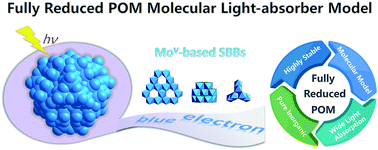An unprecedented fully reduced {MoV60} polyoxometalate: from an all-inorganic molecular light-absorber model to improved photoelectronic performance†
Abstract
Fully reduced polyoxometalates are predicted to give rise to a broad and strong absorption spectrum, suitable energy levels, and unparalleled electronic and optical properties. However, they are not available to date. Here, an unprecedented fully reduced polyoxomolybdate cluster, namely Na8[MoV60O140(OH)28]·19H2O {MoV60}, was successfully designed and obtained under hydrothermal conditions, which is rare and is the largest fully reduced polyoxometalate reported so far. The MoV60 molecule describes one Keggin {ε-Mo12} encapsulated in an unprecedented {Mo24} cage, giving rise to a double truncated tetrahedron quasi-nesting architecture, which is further face-capped by another four {Mo6} tripods. Its crystalline stability in air, solvent tolerance, and photosensitivity were all shown. As a cheap and robust molecular light-absorber model possessing wide light absorption, MoV60 was applied to build a co-sensitized solar cell photoelectronic device along with N719 dyes and the optimal power conversion efficiency was 28% higher than that of single-dye sensitization. These results show that MoV60 polyoxometalate could serve as an ideal model for the design and synthesis of all-inorganic molecular light-absorbers for other light-driven processes in the future.



 Please wait while we load your content...
Please wait while we load your content...